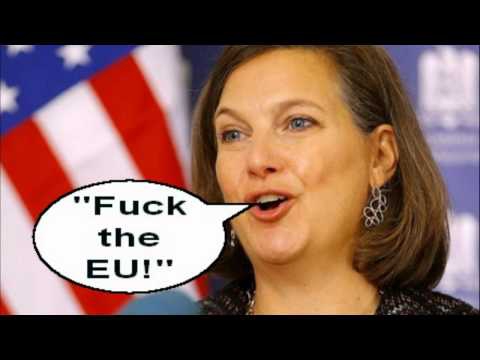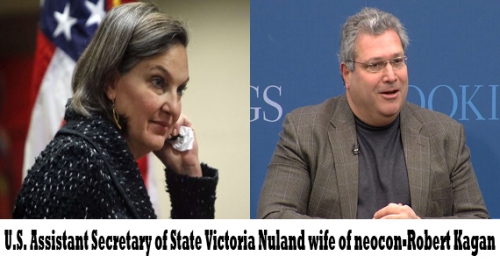Why is Victoria Nuland reliably confrontational and antagonistic toward Russia? Why does she push power, force, and military might to the forefront in Ukraine? Why does she risk war with Russia? Why does she even care about Russia’s relations with Ukraine enough to inject the U.S. government into their affairs and conflicts?
Her philosophy is the same as her husband’s, Robert Kagan. One article calls them “THE ULTIMATE AMERICAN POWER COUPLE“. It says “Victoria Nuland and Robert Kagan fell in love ‘talking about democracy and the role of America in the world’ on one of their first dates. It’s a shared passion that hasn’t faded over time.” Presumably that inner quote is from one or both of them.
For a brief profile of Robert Kagan’s ideas, shared by Victoria Nuland, see here. That article contains some criticism of their positions coming from the academic side. It is enough to know that Kagan supports Hillary Clinton in foreign policy and that she appointed Nuland to see that in foreign policy Americans at the moment have no major party presidential choice except more of the same.
Kagan and Nuland advocate U.S. activism and intervention throughout the world. Kagan has always endorsed more and more and more U.S. commitments worldwide. In September, 2003, he endorsed “a ‘generational commitment’ to bringing political and economic reform to the long-neglected Middle East–a commitment not unlike that which we made to rebuild Europe after the Second World War.” (The phrase “generational commitment’ is Condoleezza Rice’s.) The article’s title is “Do what it takes in Iraq”, which is never enough to suit Kagan. This is one of his excuses for why the policies of war and might that he advocates have failed. The U.S. doesn’t try hard enough to suit him. The U.S. tried very, very hard in Vietnam, Iraq and Afghanistan, however. It still did not produce what Kagan and Kristol glowingly wanted in any of these countries and in Libya: “American ideals and American interests converge in such a project, that a more democratic Middle East will both improve the lives of long-suffering peoples and enhance America’s national security.” The very opposite has resulted!
The projection of American power and might into these lands has not produced what Kagan and Kristol forecasted would be the result.
The ideas and policies of Kagan and Nuland are influential in Washington and on Obama. They are always the most hawkish. In a Sept. 5, 2014 essay, Kagan wrote “The most hawkish members of Congress don’t think it safe to argue for a ground attack on the Islamic State or for a NATO troop presence in Ukraine.”
 Kagan wants both an American ground attack on IS, which would mean attacks in three or more countries, and NATO in Ukraine. Nuland has constantly made provocative statements about Russia and she supports every move by Washington deeper and deeper into Ukraine’s politics and military campaigns. If Poroshenko is removed from office by another coup, Nuland will be there to influence and control the new leaders. She will anoint and bless them, even if they are neo-nazis.
Kagan wants both an American ground attack on IS, which would mean attacks in three or more countries, and NATO in Ukraine. Nuland has constantly made provocative statements about Russia and she supports every move by Washington deeper and deeper into Ukraine’s politics and military campaigns. If Poroshenko is removed from office by another coup, Nuland will be there to influence and control the new leaders. She will anoint and bless them, even if they are neo-nazis.
The same article contains Kagan’s distorted interpretation of history. Kagan stands for the liberal values that came out of the Enlightenment and characterize the Western states. But he also believes that these states are pansies who need to be muscular in defense of these values. “Muscular” means interventionist and ever-willing to insert force and arms in foreign lands; not in classic self-defense but on a pro-active, preemptive basis. In other words, to maintain liberal values and promote liberalism worldwide, the liberal states have to behave illiberally. They have to attack other countries that they deem threatening. They have to be provocative toward any country that doesn’t meet their standards of liberality.
Kagan prefers the title “liberal interventionist” (Nuland presumably is the same.) This policy position is self-contradictory. A liberal position allows for self-defense, but it does not allow for remaking the world and attacking other countries. It is not necessarily the case that when the U.S. government provokes and confronts, or even invades, other nations that have different political setups, this benefits Americans.
Kagan’s idea is that there are military solutions to what he assumes are American problems in Syria and Ukraine. He bemoans “‘There is no military solution’ is the constant refrain of Western statesmen regarding conflicts from Syria to Ukraine…”, implying that there are such solutions. But are these lands actually problems for Americans in the first place? It’s hardly obvious that they are. They become problems only when the U.S. government follows the Kagan-Nuland philosophy of liberal interventionism and inserts itself into these conflicted lands. Kagan wants military solutions for problems that he has helped to create by his constant support and promotion of interventions.
Kagan’s justification of pro-active and preemptive military interventions and military solutions goes back to his interpretation of 20th century history, in particular, the role of Germany and Japan versus the western powers. He sees appeasement as a basic component of World War II. And he argues that Germany and Japan had grievances and resentments that could not be assuaged by concessions or accommodations from the West. He transfers this argument to the present and sees new enemies and threats in Russia, China and the Middle East.
Kagan’s ideas about Japan are oversimplified. The history of Japanese-American relations has to go back to armed U.S. naval expeditions in 1846, 1848 and 1852. It has to go back to friction over the Open Door Policy and U.S. immigration policy. China became an important bone of contention. Appeasement is hardly a consideration in any of this. Just the opposite. It is American resistance to Japan’s policies in China that is a nexus of frictions.
To engage in appeasement is to make a concession over what one owns or has a legitimate interest or obligation in. What concessions or legitimate interests did the U.S. sacrifice in order to avoid war with Japan and Germany? The U.S. did not have a treaty obligation to Czechoslovakia. The U.S. didn’t sign the Munich Agreement. The U.S. didn’t undertake to enforce Wilson’s idea of self-determination of nations when they came under threat from larger powers. It cannot be said that the U.S. appeased Germany. Furthermore, the U.S. participation in World War I, which would have been approved of by the Kagan-Nuland philosophy, had results that led to World War II. It cannot be argued that the U.S. appeased Germany in and before World War I.
With respect to the U.S. and NATO, it cannot be argued today that Ukraine is another Sudetenland or Czechoslovakia. The U.S. has no treaties with Ukraine to protect the territorial integrity of Ukraine or prevent it from breaking apart in a civil war. If it did have such a treaty, as it does with a good many other countries, it would only be asking for trouble.
Kagan’s understanding of the 19th century and appeasement is subject to serious questions. And when one considers how different the situations are today with respect to those states or countries that he seeks to replace Germany and Japan with, such as Iraq, Libya, Afghanistan, Islamic State, Russia and China, the Kagan-Nuland philosophy of American force projection is far more simply needless provocation and war-making than the non-appeasement that Kagan and Nuland envision it to be. Furthermore, the military intrusions of the U.S. can hardly be said to have appeased anyone; and they have done nothing to promote those liberal interventionist aims that Kagan and Nuland fell in love over.





 del.icio.us
del.icio.us
 Digg
Digg
Les commentaires sont fermés.